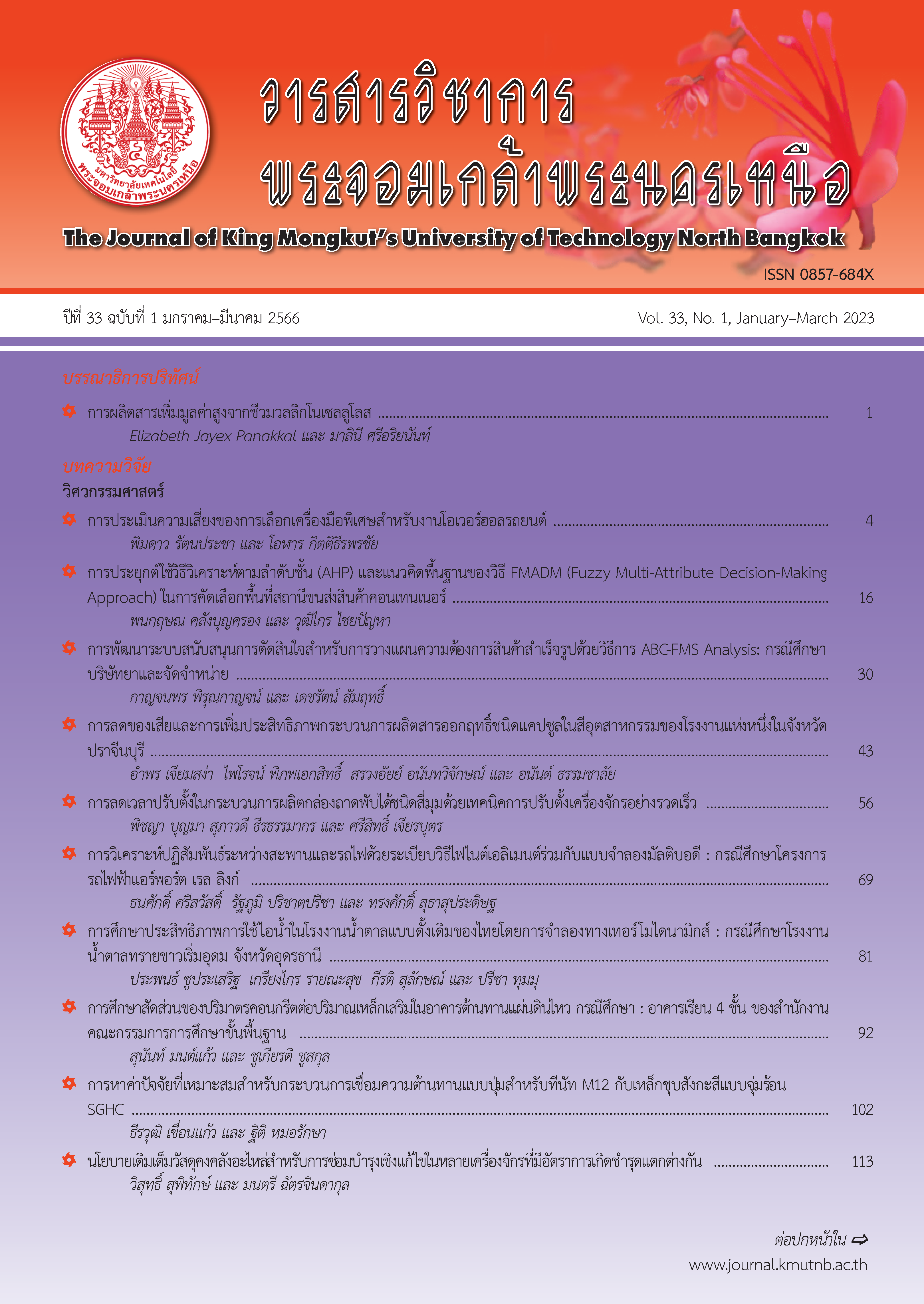การบำบัดน้ำล้างทรายปนเปื้อนปิโตรเลียมไฮโดรคาร์บอนด้วยกระบวนการเปอร์ซัลเฟต และกระบวนการโซโน-เปอร์ซัลเฟตออกซิเดชัน
Main Article Content
บทคัดย่อ
งานวิจัยนี้มีวัตถุประสงค์เพื่อศึกษาการสกัดคราบปิโตรเลียมไฮโดรคาร์บอน (TPH) ในทราย และศึกษาสภาวะที่เหมาะสมในการบำบัดน้ำเสียปนเปื้อนปิโตรเลียมไฮโดรคาร์บอนหลังการสกัดออกจากทรายโดยกระบวนการเปอร์ซัลเฟตและ โซโน-เปอร์ซัลเฟตออกซิเดชัน งานวิจัยนี้แบ่งเป็น 2 ส่วน คือ ส่วนที่ 1 ศึกษาการสกัดปิโตรเลียมไฮโดรคาร์บอนในทราย 5,000 mg/kg โดยใช้สารลดแรงตึงผิว Sodium dodecyl Sulfate (SDS) และ Polysorbate 20 (Tween 20) ที่ความเข้มข้น 0.05-0.4 โมลาร์ ระยะเวลา 0-120 นาที พบว่าที่ความเข้มข้น 0.1-0.4 โมลาร์และ ระยะเวลา 20-120 นาที สามารถสกัด TPH ออกจากทรายได้ร้อยละ 98 และ 99 ตามลำดับ ส่วนที่ 2 ศึกษาสภาวะที่เหมาะสมในการบำบัดน้ำเสียปนเปื้อนปิโตรเลียมไฮโดรคาร์บอนหลังการสกัดออกจากทรายด้วยกระบวนการเปอร์ซัลเฟตและ โซโน-เปอร์ซัลเฟตออกซิเดชัน โดยศึกษาความเข้มข้นของเฟอรัสไอออนและ ความเข้มข้นของเปอร์ซัลเฟตที่เหมาะสมตั้งแต่ 0.0-0.5 โมลาร์ ค่าความเป็นกรด-ด่าง 2-6 ระยะเวลาในการเกิดปฏิกิริยาเปอร์ซัลเฟตออกซิเดชัน 0-60 นาที และระยะเวลาในการเกิดปฏิกิริยาโซโน-เปอร์ซัลเฟตออกซิเดชัน 0-50 นาที จากการศึกษาพบว่าประสิทธิภาพในการบำบัดในน้ำเสียปนเปื้อนหลังการสกัดด้วย SDS และTween20 ดีที่สุดเมื่อใช้เฟอรัสไอออน 0.1 โมลาร์ เปอร์ซัลเฟต 0.2 โมลาร์ ในน้ำเสียปนเปื้อนหลังการสกัดด้วย SDS และ 0.3 โมลาร์ ในน้ำเสียปนเปื้อนหลังการสกัดด้วย Tween20 ตามลำดับ ความเป็นกรด-ด่างเท่ากับ 3 ระยะเวลาในการเกิดปฏิกิริยาเปอร์ซัลเฟตออกซิเดชันที่ 60 นาที ประสิทธิภาพในการบำบัดในน้ำเสียปนเปื้อนหลังการสกัดด้วย SDS และTween20 โดยกระบวนการเปอร์ซัลเฟต ร้อยละ 83.97 และ 75.90 ตามลำดับ และประสิทธิภาพในการบำบัดโดยกระบวนการโซโน-เปอร์ซัลเฟตออกซิเดชันที่ 40 นาที ร้อยละ 79.66 และ 71.25 ตามลำดับ นอกจากนี้พบว่ากระบวนการโซโน-เปอร์ซัลเฟตมีความถี่เหนือแสงเป็นตัวช่วยเร่งปฏิกิริยาทำให้เกิดปฏิกิริยาออกซิเดชันได้เร็วกว่ากระบวนการเปอร์ซัลเฟตอีกด้วย
Article Details

อนุญาตภายใต้เงื่อนไข Creative Commons Attribution-NonCommercial-NoDerivatives 4.0 International License.
บทความที่ลงตีพิมพ์เป็นข้อคิดเห็นของผู้เขียนเท่านั้น
ผู้เขียนจะต้องเป็นผู้รับผิดชอบต่อผลทางกฎหมายใดๆ ที่อาจเกิดขึ้นจากบทความนั้น
เอกสารอ้างอิง
F. Y. Ushikubo and R. L. Cunha, “Stability mechanisms of liquid water in oil emulsions,” Food Hydrocolloids, vol 34, pp. 145–153, January 2014.
J. Deng, Y. Shao, N. Gao, Y. Deng, C. Tan, and S. Zhou, “Zero-valent iron/persulfate (Fe0/PS) oxidation acetaminophen in water,” Environmental Science and Technology, vol. 11, no. 4, pp. 881–890, 2013.
M. Pacwa-Płociniczak, J. Czapla, T. Płociniczak, and Z. Piotrowska-Seget, “The effect of bioaugmentation of petroleum-contaminated soil with Rhodococcus erythropolis strains on removal of petroleum from soil,” Ecotoxicology and Environmental Safety, vol. 196, pp. 615–622, 2019.
C. Uzochukwu, Ugochukwu, A. Ochonogor, C. M. Jidere, A. Chizoba, N. Frida, E. John, and Virginia U. Okwu-Delunzu, “Exposure risks to polycyclic aromatic hydrocarbons by humans and livestock (cattle) due to hydrocarbon spill from petroleum products in Niger-delta wetland,” Environmentel International, vol. 115, pp. 38–47, 2018.
A. Naksuk, D. A. Sabatini, and C. Tongcumpou, “Microemulsion-based palm kernel oil extraction using mixed surfactant solutions,” Industrial Crops and Products, vol. 30, pp. 194–198, 2009.
M. Fingasa and B. Fieldhouseb, “Studies on water-in-oil products from crude oils and petroleum products,” Marine Pollution Bulletin, vol. 64, pp. 272–283, 2012.
I. K. Sezin, T. T. Phan, and A. S. David, “Surfactant based oil extraction of corn germ,” Journal of the American Oil Chemists’ Society, vol. 88, no. 6, pp. 863–869, 2011.
L. D. Do and D. A. Sabatini, “Aqueous extendedsurfactant based method for vegetable oil extraction,” Journal of the American Oil Chemists’ Society, vol. 87, no. 10, pp. 1211–1220, 2010.
W. Phoochinda, D. A. White, and B. J. Briscoe, “An algal removal using a combination of flocculation and flotation processes,” Environmental Technology, vol. 25, pp. 1385– 1395, 2004.
EL Moaty and S. Ibrahim, “Surfactant properties of corrosion inhibitors,” Ph.D. dissertation, Nalco Chemical Company, University of Hull, 2011.
M. A. Aboulhassan, S. Souabi, A. Yaacoubi, and M. Baudu, “Removal of surfactant from industrial wastewaters by coagulation flocculation process,” Environmental Science and Technology, vol. 3, no. 4, pp. 327–332, 2006.
S. A. Awatif, H. K. Basim, and K. A. Sura, “Evaluating water stability indices from water treatment plants in baghdad city,” Journal of Water Resource and Protection, vol. 6, no. 14, pp. 1344–1351, 2014.
E. Chamarro, A. Marco, and S. Esplugas, “Use of fenton reagent to improve organic chemical biodegradability,” Water Research, vol 35, no. 4, pp. 1047–1051, 2001.
L. Chenju, H. Chiu-Fen, and C. Yan-Jyun, “Potential for activated persulfate degradation of BTEX contamination,” Water Research, vol. 42, no. 15, pp. 4091–4100, 2008.
L. Hui, G. Jing, Y. Lijiao, and L. Yeqing, “Degradation of methyl orange by sodium persulfate activated with zero-valent zinc,” Separation and Purification Technology, vol. 132, pp. 168–173, 2014.
J. R. Milton, “Surfactants and interfacial phenomena,” Surfactant Research Institute Brooklyn College the City University of New York, vol. 3, pp. 1–32, 2004.
F. Guo-Dong, D. D. Dionysios, Z. Dong-Mei, Y. Wang, Z. Xiang-Dong, F. Jian-Xin, C. Long, and W. Yu-Jun, “Transformation of polychlorinated biphenyls by persulfate at ambient temperature,” Chemosphere, vol. 90, no. 5, pp. 1573–1580, 2013.
P. Nikolaos, F. Zacharias, A. Maria, K. Ioannis, and M. Dionissios, “Oxidation of bisphenol: A in water by heat-activated persulfate,” Journal of Environmental Management, vol. 195, pp. 125–132, 2017.
L. Chenju, J. B. Clifford, C. M. Michael, and L. S. Kenneth, “Persulfate oxidation for in situ remediation of TCE. I. Activated by ferrous ion whith and without a persulfate-thiosulfate redox couple,” Chemosphere, vol. 55, no. 9, pp. 1213–1223, 2004.
Z. Guangyin, L. Xueqin, S. Lianghu, K. Takuro, K. Gopalakrishnan, Z. Tao, X. Kaiqin, L. Yu-You, Z. Xuefeng, and Z. Youcai, “Unraveling the catalyzing behaviors of different iron species (Fe2+ vs. Fe0) in activating persulfate-based oxidation process with implications to waste activated sludge dewaterability,” Water Research, vol. 134, pp. 101–114, 2018.
G. Ivana, S. Ana, K. Natalija, and V. Domagoj, “Global parameter of ultrasound exploitation (GPUE) in the reactors for wastewater treatment by sono-Fenton oxidation,” Ultrasonics Sonochem, vol. 19, no. 2, pp. 270–279, 2012.

